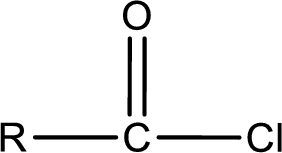
(a)
Interpretation:
Condensed structural formula for the organic product that is formed when butanoyl chloride reacts with water has to be drawn.
Concept Introduction:
Acid chlorides are organic derivatives of carboxylic acid. The difference between carboxylic acid and acid chloride structure is that the

Acid chlorides react with water to give carboxylic acid and hydrogen chloride. The carboxylic acid formed from acid chloride is the parent carboxylic acid. The general reaction scheme of acid chloride reaction with water can be given as,

(b)
Interpretation:
Condensed structural formula for the organic product that is formed when butanoic anhydride reacts with water has to be drawn.
Concept Introduction:
Acid anhydrides are organic derivatives of carboxylic acid. The difference between carboxylic acid and acid anhydride structure is that the

Acid anhydride on reaction with water undergoes hydrolysis to form two carboxylic acid molecules. If the acid anhydride is a symmetric one, then two molecules of same carboxylic acid is obtained on hydrolysis. If the acid anhydride is an asymmetric one, the two molecules of two different carboxylic acid molecules are obtained. The general reaction can be given as,

Want to see the full answer?
Check out a sample textbook solution
Chapter 16 Solutions
General, Organic, and Biological Chemistry
- draw the structure of benzoic acid.arrow_forwardWhat reagents are used in the esterification of Alcohols and Phenols? a.Write the reaction involved in Primary Alcohol (Ethanol) and Acetyl Chloride b. Write the reaction involved in Phenol and Acetyl Chloridearrow_forwarda.) Look up the structure of salicylic acid and the structure of acetic anhydride. Indicate where the two molecules would attach to form aspirin (acetylsalicylic acid). See if you can predict the remaining product in the synthesis. b.) What carboxylic acid and what alcohol react to produce propyl acetate (pear flavoring/smell)?arrow_forward
- (a) Write a chemical test to distinguish between: (i) Chlorobenzene and Benzyl chloride. (ii) Chloroform and Carbon tetrachloride. (b) Why is methyl chloride hydrolysed more easily than chlorobenzene?arrow_forwardWhen reacted with mineral chameleon, the product of initial oxidation of grain alcohol is ____?arrow_forwardName each of the following as a derivative of phenol: a. b.arrow_forward
- List the following compounds in order of increasing water solubility: a.ethoxyethane b.propanoic acid c.pentane d.1 butanolarrow_forwardDraw the all the reactants and products involved in a condensation reaction between propanoic acid and ethanamine. Make sure to include the catalyst needed and any secondary products that would form.arrow_forwardWrite the chemical equations for tollen's test reaction for (Use structural formula) a. n-hexane b. cyclohexene c. benzene d. toluenearrow_forward
 Chemistry for Today: General, Organic, and Bioche...ChemistryISBN:9781305960060Author:Spencer L. Seager, Michael R. Slabaugh, Maren S. HansenPublisher:Cengage Learning
Chemistry for Today: General, Organic, and Bioche...ChemistryISBN:9781305960060Author:Spencer L. Seager, Michael R. Slabaugh, Maren S. HansenPublisher:Cengage Learning Organic And Biological ChemistryChemistryISBN:9781305081079Author:STOKER, H. Stephen (howard Stephen)Publisher:Cengage Learning,
Organic And Biological ChemistryChemistryISBN:9781305081079Author:STOKER, H. Stephen (howard Stephen)Publisher:Cengage Learning, General, Organic, and Biological ChemistryChemistryISBN:9781285853918Author:H. Stephen StokerPublisher:Cengage Learning
General, Organic, and Biological ChemistryChemistryISBN:9781285853918Author:H. Stephen StokerPublisher:Cengage Learning


